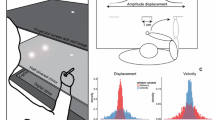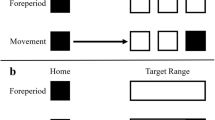Abstract
To hit moving targets, one not only has to arrive at the right place but also at the right time. Moving quickly reduces spatial precision but increases temporal precision. This may explain why people usually move more quickly toward fast targets than toward slow ones, because arriving at the right time is more important when hitting fast targets. The temporal accuracy required depends not only on the target’s speed but also on its length in the direction of motion; it decreases with increasing length. Here we investigate the effects of variations in the target’s speed and dimensions on the subject’s movement time. We asked subjects to hit targets that moved from left to right as quickly as possible with their index finger. The targets varied in length in the direction of motion (width: affecting both spatial and temporal demands), in length in the orthogonal direction (height: affecting spatial demand), and in speed (affecting temporal demand). Targets were presented in random order during one session and in blocks of trials with identical targets during another session. In the latter session subjects could optimize their strategy for each target separately. In the random condition subjects hit fast targets more quickly than slow ones. Their movement time was also affected by the target’s size (the spatial demand), but not by the direction of the elongation. For the blocked condition, subjects did consider the direction of the elongation. We conclude that people do not consider an object’s orientation to estimate the temporal demands of an interception task, but that they use the object’s size and speed, and their experience from previous trials.





Similar content being viewed by others
Notes
Throughout the whole paper, “accuracy” can be read as “accuracy and precision”, i.e. both a correct average value and low variability.
We only consider the temporal and spatial errors of the movement endpoint, irrespective of their causes (van Beers et al. 2004).
References
Brenner E, de Lussanet MHE, Smeets JBJ (2002) Independent control of acceleration and direction of the hand when hitting moving targets. Spat Vis 15:129–140
Brouwer A, Brenner E, Smeets JBJ (2000) Hitting moving objects: the dependency of hand velocity on the speed of the target. Exp Brain Res 133:242–248
Brouwer A, Brenner E, Smeets JBJ (2002) Hitting moving objects: is target velocity used in guiding the hand? Exp Brain Res 143:198–211
Brouwer A, Middelburg T, Smeets JBJ, Brenner E (2003) Hitting moving targets: using the target’s direction of motion. Exp Brain Res 152:368–375
Caljouw SR, van der Kamp J, Savelsbergh GJP (2004) Catching optical information for the regulation of timing. Exp Brain Res 155:427–438
Carnahan H, McFadyen BJ (1996) Visuomotor control when reaching toward and grasping moving targets. Acta Psychol 92:17–32
De Lussanet MHE, Smeets JBJ, Brenner E (2001) The effect of expectations on hitting moving targets: influence of the preceding target’s speed. Exp Brain Res 137:246–248
Drewing K, Aschersleben G (2003) Reduced timing variability during bimanual coupling: a role for sensory information. Q J Exp Psychol A 56:329–350
Fayt V, Bootsma RJ, Marteniuk RG, Mackenzie CL, Laurent M (1997) The effects of task constraints on the organization of interception movements. J Sport Sci 15:581–586
Fetterman JG, Killeen PR (1990) A componential analysis of pacemaker-counter timing systems. J Exp Psychol Hum Percept Perform 4:766–780
Fitts PM, Peterson JR (1964) Information capacity of discrete motor responses. J Exp Psychol 67:103–112
Harris CM, Wolpert DM (1998) Signal dependent noise determines motor planning. Nature 384:780–784
Ivry RB, Hazeltine RE (1995) Perception and production of temporal intervals across a range of durations: evidence for a common timing mechanism. J Exp Psychol Hum Percept Perform 21:3–18
Landy MS, Goutcher R, Trommershäuser J, Maloney LT, Mamassian P (2004) MEGaVis: perceptual decisions in the face of explicit costs and benefits. VSS Abstract book, T40, 38
Messier J, Kalaska JF (1997) Differential effect of task conditions on errors of direction and extent of reaching movements. Exp Brain Res 115:469–478
Newell KM, Hoshizaki LEF, Carlton MJ, Halbert JA (1979) Movement time and velocity as determinants of movement timing accuracy. J Mot Behav 11:49–58
Savelsbergh GJP, Whiting HTA, Burden AM, Bartlett RM (1992) The role of predictive visual temporal information in the coordination of muscle activity in catching. Exp Brain Res 89:223–228
Schmidt RA (1969) Movement time as a determiner of timing accuracy. J Exp Psychol 79:43–47
Smeets JBJ, Brenner E (1995) Perception and action based on the same visual information: distinction between position and velocity. J Exp Psychol Hum Percept Perform 21:19–31
Tresilian JR, Lonergan A (2002) Intercepting a moving target: effects of temporal precision constraints and movement amplitude. Exp Brain Res 142:193–207
Tresilian JR, Oliver J, Carroll TJ (2003) Temporal precision of interceptive action: differential effects of target size and speed. Exp Brain Res 148:425–438
Tresilian JR, Plooy A, Carroll TJ (2004) Constraints on the spatiotemporal accuracy of interceptive action: effects of target size on hitting a moving target. Exp Brain Res 155:509–526
Trommershäuser J, Maloney LT, Landy MS (2003a) Statistical decision theory and the selection of rapid, goal-directed movements. J Opt Soc Am A 7:1419–1433
Trommershäuser J, Maloney LT, Landy MS (2003b) Statistical decision theory and trade-offs in the control of motor response. Spat Vis 16:255–275
Van Beers RJ, Haggard P, Wolpert DM (2004) The role of execution noise in movement variability. J Neurophysiol 91:1050–1063
Van Donkelaar P, Lee RG, Gellman RS (1992) Control strategies in directing the hand to moving targets. Exp Brain Res 91:151–161
Vindras P, Viviani P (1998) Frames of reference and control parameters in visuomanual pointing. J Exp Psychol Hum Percept Perform 24:569–591
Acknowledgements
This research was supported by the European Commission (Grant HPRN-CT-2002-00226). We thank two anonymous reviewers for their helpful comments.
Author information
Authors and Affiliations
Corresponding author
Rights and permissions
About this article
Cite this article
Brouwer, AM., Smeets, J.B.J. & Brenner, E. Hitting moving targets: effects of target speed and dimensions on movement time. Exp Brain Res 165, 28–36 (2005). https://doi.org/10.1007/s00221-005-2277-y
Received:
Accepted:
Published:
Issue Date:
DOI: https://doi.org/10.1007/s00221-005-2277-y




